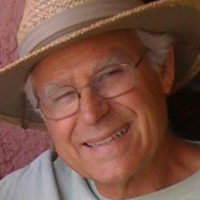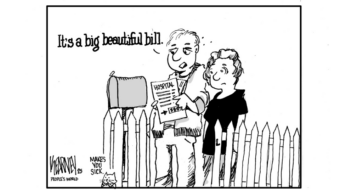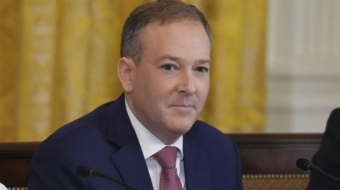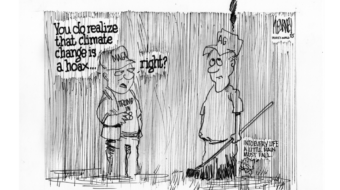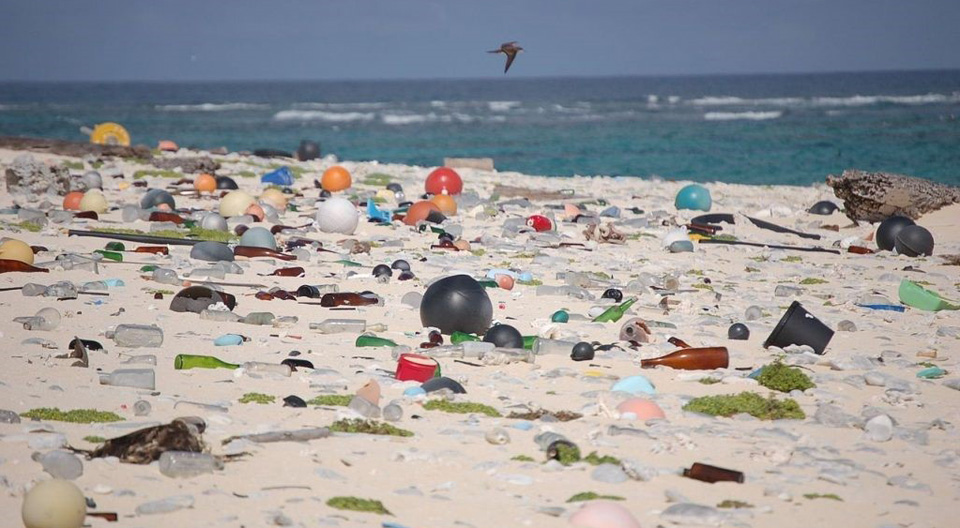
The new Trump White House website doesn’t mention human-caused climate change. It shows the new president’s energy plan, but there’s no mention of anything having to do with climate, aside from Trump’s commitment to eliminating “harmful and unnecessary policies such as the Climate Action Plan.”
Now Scott Pruitt, the new director of the Environmental Protection Agency, says he doesn’t think carbon dioxide produced by human activity drives global climate change. Meanwhile, his subordinates continue to do their work, but are banned from speaking to the press, granting contracts, or posting their studies on social media. “The entire agency is under lockdown,” one EPA employee stated. Apparently, out of sight, out of mind. If we don’t say it exists, it doesn’t.
The problem, however, does not go away because the administration muzzles agencies charged to deal with it. Whether or not you think humans cause it, climate change continues to fester. I’ve seen Chicago when the peaking waves from the lake were frozen solid. Not this year. As of early March, Chicago saw 77 days without at least an inch of snow, and temperatures in the balmy 60s—in mid-winter. Ice continues to melt in Greenland and Antarctica—annually about 303 gigatons from the former, 118 gigatons from the latter. A chunk 1930 square miles is about to break off Antarctica. Researchers know that these melts raise the sea level, but we now also know that the sea-rise is faster than at any time in the past 3000 years.
So Rio de Janeiro suffers lost beaches, not just from rising seas, but also from unusually powerful storms, with 12-foot waves dumping sand onto adjacent roadways. In August last year, Louisiana got hit by a storm ranked as a once-in-500-year event—except it was the eighth such storm in 12 months to hit this continent (these storms included Georgia’s deadly January tornado). And last year was the hottest year ever—tracking on 14 months in a row of record-breaking temperatures. We are suffering a period of extreme weather patterns that a German insurance company says could only happen because of climate change. Nearly half of Trump supporters recognize global warming, according to a Yale/George Mason poll, and a quarter of Trump supporters acknowledge climate change is caused by us humans, according to a University of New Hampshire survey.
The evidence proving a human toll on the environment has been clear for some time:
- Each year people dump eight million tons of plastic into the ocean. Much of the debris gathers in convergence areas in the Pacific Ocean, according to the National Oceanic and Atmospheric Administration.
- Human manufactured pesticides are killing pollinators, the bees, butterflies, and other tiny creatures that crucially spread pollen for more than 75 percent of the crops which we depend on for food and fiber.
- Larger animals face mass extinction because people farm, hunt, mine and otherwise disrupt the ecology of vast portions of the planet. From Madagascar to the Congo to Brazil to Indonesia, human activity threatens as much as 60 percent of some 504 species tracked by researchers.
- Our impact reaches the ocean’s deepest depths—places like the Mariana Trench, over six miles down. At the trench’s bottom, scientists have discovered toxic chemical concentrations in tiny creatures that are 50 times the rate found in fish from China’s most polluted rivers.
These studies and facts provide evidence that whether or not you think human activity changes climate, it certainly impacts even the most isolated reaches of the planet.
People who don’t think climate change is human-caused have to ignore all that impact. They have to think that fracking in Oklahoma hasn’t led to a dramatic increase in earthquakes—from fewer than 250 over a century, to more than that just last year. They have to ignore evidence that pesticides affect the health of children in agricultural areas. They have to think that greenhouse-gas emissions don’t endanger people’s health.
They also must ignore the positive results when the world does understand a problem and makes changes to fix it. The hole in the ozone caused by CFCs was discovered in the 1980s, and nations agreed to ban them. Between 2000 and now, the ozone hole has shrunk by 1.5 million square miles. When people act they can heal the ruptures.
So our human impact is unmistakable. Whether for good or for ill, we affect every other entity in our world. If we continue to live the way we do, the results will be dire—for humans, even rich ones, and for many animals, for plants and the vast seas. We can certainly change our course. But not if out-of-sight means out-of-mind. Ignoring climate change won’t make it go away. Denying human involvement won’t get us to fix it—if we still can.
Reposted by kind permission of the author and Capital & Main.


